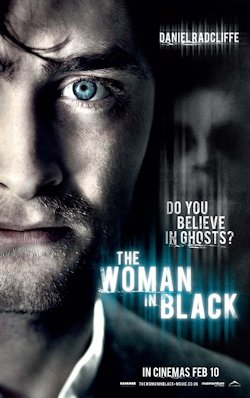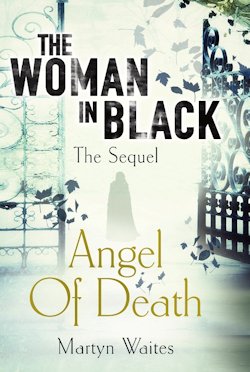What a wonderful ghost story The Woman in Black was! Who, who has read the original 1983 novella, could possibly have forgotten the fate of Susan Hill’s determined central character, the solicitor Arthur Kipps—not to mention his unfortunate family? Who, I ask you, slept soundly after having heard tell of the tragedy of Jennet Humfrye, the half-mad mother who saw her only son sucked into the murderous muck of the causeway connecting her home to the eerie village of Crythin Gifford? Who, in the end, could hold her haunting of Eel Marsh House against her?
Over the course of The Woman in Black: Angel of Death, I came to, I’m afraid. In this “fully authorised” sort-of-sequel, though it be blessedly brief, her “bleached-bone” features appear so frequently that she seemed less chilling, not to mention sympathetic, than the wilting wallpaper which adorns the walls of the ancient estate where at the outset our hapless protagonist is dispatched.
Forty-odd years on from the events of the darkly fantastic classic this new book purports to take its cues from, the Blitz is in full swing. Eve Parkins, a trainee teacher, removes a class of children from the dangers of living in London—and from the comfort of their families, it follows—to a mouldering old mansion in the countryside where weird things start happening immediately.
Realising that something is amiss, Eve digs into the building’s history, by way of which she becomes convinced that Eel Marsh House is haunted by some vengeful spectre:
“Whenever she is seen […] a child dies. That’s her curse. She lost her only child, so she took revenge on the village by killing all their children. And now we’ve arrived here, it’s started again…”
Which is to say, in full command of her supernatural powers, now, and presented with the equivalent of a buffet lunch after having gone horribly hungry, the woman in black starts murdering children willy-nilly—draping one from the barbed wire surrounding the house, suffocating another in a gas mask, and so on.
That’s pretty much the plot—in short, a paltry lot—and the characters are hardly more substantial. Eve is an example of a protagonist on auto-pilot; she behaves in exactly the ways we expect, doing no more, and no less. Even her affair with Harry, an RAF man she meets on the train leaving London, seems as paper-thin as she. Only the headmistress, mean Jean, felt decently developed to me. You see, she has principles: principles that, however wrong-headed, we can respect.
The boys and girls, meanwhile, are deserving of precisely this much discussion.
Out of the gate, the very thought of a sequel to a The Woman in Black struck me as strange, particularly considering the conclusive denouement of that classic. “They asked for my story. I have told it. Enough,” it ends. Or did do.

That the woman in black is back is no surprise, I suppose. As the blurb of this brief sequel reminds us, quite aside the immense success of Susan Hill’s short novel, said story has been the basis of the second longest running stage play in the history of the West End, whilst the recent adaptation starring Daniel Radcliffe is officially “the highest-grossing UK horror film of all time. Its sequel […] is scheduled for major release on the big screen in 2014.”
With which the pieces of the puzzle begin to come together. Though the press release I received reports that this is “the book that the follow-up film […] will be based on,” other sources suggest that it is in fact a novelisation of a script by a screenwriter called Jon Croker adapted from “the core of an original idea” by the estimable author of last year’s delectable Dolly.
That is to say, don’t blame Martyn Waites, who doesn’t “normally hold with all that supernatural nonsense” in any case. Rather, his is “a practical vocabulary not given to flights of fancy,” in light of which lack he equips himself relatively well. The prose itself is sound; the short chapters keep things lively, at least; and there are a few perfectly serviceable scares.
Whatever the case may be, The Woman in Black: Angel of Death adds nothing of note to the classic narrative. Perhaps the cheap tricks it puts its transparent protagonist through will work better on film than in literature. I suppose we’ll see next year. Or maybe we’ll have learned our lesson by then…
The Woman in Black: Angel of Death is available now in the UK from Hammer Books.
Niall Alexander is an extra-curricular English teacher who reads and writes about all things weird and wonderful for The Speculative Scotsman, Strange Horizons, and Tor.com. He’s been known to tweet, twoo.










